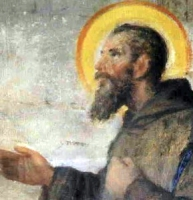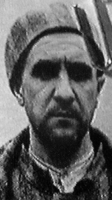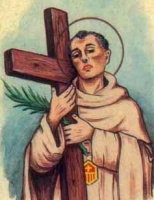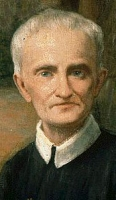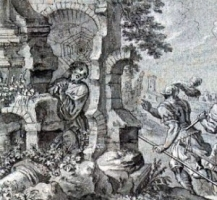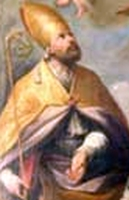St. Beauch (Bagug)
Feastday: January 15
martyred at Tina (Kau) in Kemet. Sentenced at Antinoe by order of Arrhianus.
St. Paul the Hermit
புனிதர் வனத்துச் சின்னப்பர்
முதல் வனவாச துறவி:
பிறப்பு: கி.பி. 227
எகிப்து (Egypt)
இறப்பு: கி.பி. 342
புனித வனத்து சின்னப்பர் துறவு மடம், எகிப்து
ஏற்கும் சமயம்:
கத்தோலிக்க திருச்சபை
கிழக்கு மரபுவழி திருச்சபை
ஓரியண்டல் மரபுவழி திருச்சபைகள்
முக்கிய திருத்தலங்கள்:
புனித வனத்து சின்னப்பர் துறவு மடம், எகிப்து
நினைவுத் திருவிழா: ஜனவரி 15
சித்தரிக்கப்படும் வகை:
இரண்டு சிங்கம், ஈச்ச மரம், காகம்
பாதுகாவல்:
சென் ஃபேபுலோ நகர், பிலிப்பைன்ஸ்
முதலாம் நூற்றாண்டில் வாழ்ந்த புனிதர் வனத்து சின்னப்பர், வனவாசம் செய்த முதல் கிறிஸ்தவ துறவி ஆவார். தமது பதினாறு வயது முதல், நூற்றுப் பதின்மூன்று வயதுவரை பாலைவனங்களில் தனிமையில் துறவு வாழ்க்கை வாழ்ந்தவராவார்.
இவரது சரித்திரம், புனிதர் ஜெரோம் அவர்களால் கி.பி. சுமார் 375 அல்லது 376ம் ஆண்டுகளில் இலத்தீன் மொழியில் எழுதப்பட்டது. இவர் எகிப்து நாட்டின் "தெபெய்த்" (Thebaid of Egypt) என்னும் பழங்கால நகரில் பிறந்தவர் ஆவார். இவருக்கு ஒரு சகோதரி இருந்தார். அவர் திருமணமானவர் ஆவார். இவர்களுடைய பெற்றோர் ஏற்கனவே இறந்து போய்விட்டார்கள்.
கி. பி. 250ம் ஆண்டு, அரசர்கள் “தேசியஸ்” (Decius) மற்றும் “வலேரியனஸ்” (Valerianus) ஆகியோர் கிறிஸ்தவர்களுக்கு எதிரான வேத கலகத்தை தொடங்கியபோது, பவுலின் மைத்துனர் இவரது பங்கு சொத்துக்களை அபகரிக்கும் நோக்கில், இவரை கலகக்காரர்களிடம் காட்டிக்கொடுக்க எண்ணினார்.
இதனை அறிந்துகொண்ட பவுல் தன் உடைமை அனைத்தையும் சகோதரியிடமும் மைத்துனரிடமும் விட்டுவிட்டு "தெபேன்" பாலைவனத்துக்கு (Theban desert) ஓடிப்போனார். அங்கே ஒரு மலைக் குகையில் வாழ்ந்து வந்தார். அப்போது இவருக்கு வயது இருபத்திரண்டு. அக்குகைக்கு அருகே இருந்த ஈச்ச மரக்கனியை உண்டு, அருகிலிருந்த அருவியில் நீர் அருந்தி வாழ்ந்துவந்தார். அதன் பின்பு ஒரு காகம் கொண்டுவந்த ரொட்டியை தினமும் உண்டு வாழ்ந்தார்.
யாரும் அறியாத ஓர் இடத்தில் 70 ஆண்டுகளுக்கும் மேலாக கடும் தவம் மேற்கொண்டார். அங்கு அவரை இறைவன் பல வழிகளில் காத்து வந்ததாக பல கதைகள் உண்டு. காட்டில் அவர் வாழ்ந்த குகையிலேயே ஒரு புனிதராக உயிர் துறந்தார்.
புனிதர் ஜெரோம் தனது (Vitae Patrum) என்னும் சரித்திர நூலில் புனித வனத்து சின்னப்பரை அவரது 113ம் வயதில் சந்தித்ததையும், ஒரு பகல், ஒரு இரவு அவருடன் உரையாடியதையும் குறிப்பிட்டிருக்கிறார். அடுத்த முறை சந்திக்க சென்றபோது, இவர் இறந்து போயிருந்ததாகவும், இரு சிங்கங்களின் துணையோடு இவரை அடக்கம் செய்ததையும் குறிப்பிடுகிறார்.
இரண்டு சிங்கம், ஈச்ச மரம் மற்றும் காகம் இவரது சின்னமாக கருதப்படுகின்றன.
கத்தோலிக்கத் திருஅவை, இவரை, புனித வனத்துச் சின்னப்பர் (St. Paul the Hermit) என்ற அடைமொழியுடன் சிறப்பிக்கிறது.
இவரது நினைவுத் திருநாள் 10 January/15 January (Catholic Church)
15 January (Eastern Orthodox Church)[1]
9 February (Coptic Orthodox Church)
Born c. 227 AD
Egypt
Died c. 341 AD
Thebes, Egypt
Venerated in Catholic Church
Eastern Orthodox Churches
Oriental Orthodox Churches
Anglican Communion
Major shrine Monastery of Saint Paul the Anchorite, Egypt
Feast
10 January/15 January (Catholic Church)
15 January (Eastern Orthodox Church)[1]
9 February (Coptic Orthodox Church)
Attributes Two lions, palm tree, raven
Also known as Paul the First Hermit and Paul of Thebes, an Egyptian hermit and friend of St. Jerome. Born in Lower The baid, Egypt, he was left an orphan at about the age of fifteen and hid during the persecution of the Church under Emperor Traj anus Decius. At the age of twenty two he went to the desert to circumvent a planned effort by his brother in law to report him to authorities as a Christian and thereby gain control of his property. Paul soon found that the eremitical life was much to his personal taste, and so remained in a desert cave for the rest of his reportedly very long life. His contemplative existence was disturbed by St. Anthony, who visited the aged Paul. Anthony also buried Paul, supposedly wrapping him in a cloak that had been given to Anthony by St. Athanasius. According to legend, two lions assisted Anthony in digging the grave. While there is little doubt that Paul lived, the only source for details on his life are found in the Vita Pauli written by St. Jerome and preserved in both Latin and Greek versions.
Paul of Thebes (Coptic: Ⲁⲃⲃⲁ Ⲡⲁⲩⲗⲉ; Koinē Greek: Παῦλος ὁ Θηβαῖος, Paûlos ho Thēbaîos; Latin: Paulus Eremita; c. 227 – c. 341), commonly known as Paul the First Hermit or Paul the Anchorite, was an Egyptian saint regarded as the first Christian hermit, who was claimed to have lived alone in the desert of Thebes, Roman Egypt from the age of sixteen to the age of one hundred and thirteen years old. He was canonized in 491 by Pope Gelasius I, and is venerated as a saint by the Catholic Church, Eastern Orthodox Church, and Oriental Orthodox Churches.[2][3][4]
Legend
Relics of Paul of Thebes preserved in the Roman Catholic basilica Santa Maria in Porto, Ravenna.
The Life of Saint Paul the First Hermit was composed in Latin by Saint Jerome, probably in 375–376.[5] Paul of Thebes was born around 227 in the Thebaid of Egypt.[6]
Paul and his married sister lost their parents. In order to obtain Paul's inheritance, his brother-in-law sought to betray him to the persecutors.[5] According to Jerome's Vitae Patrum (Vita Pauli primi eremitae[7]), Paul fled to the Theban desert as a young man during the persecution of Decius and Valerianus around AD 250.[8]
He lived in the mountains of this desert in a cave near a clear spring and a palm tree, the leaves of which provided him with clothing and the fruit of which provided him with his only source of food until he was 43 years old, when a raven started bringing him half a loaf of bread daily. He would remain in that cave for the rest of his life, almost a hundred years.[6]
Paul of Thebes visits Anthony the Great; illustration from the Breviarium ordinis fratrum eremitarum Sancti Pauli primi eremite, Velence, 1540.
Paul of Thebes is known to posterity because around the year 342, Anthony the Great was told in a dream about the older hermit's existence, and went to find him.[9]
Jerome related that Anthony the Great and Paul met when the latter was aged 113. They conversed with each other for one day and one night. The Synaxarium shows each saint inviting the other to bless and break the bread, as a token of honor. Paul held one side, putting the other side into the hands of Father Anthony, and soon the bread broke through the middle and each took his part. When Anthony next visited him, Paul was dead. Anthony clothed him in a tunic which was a present from Athanasius of Alexandria and buried him, with two lions helping to dig the grave.[9] Father Anthony returned to his monastery taking with him the robe woven with palm leaf.[9] He honored the robe so much that he only wore it twice a year: at the Feast of Easter, and at the Pentecost.[6]
Veneration
His feast day is 15 January in the liturgical calendar of the Extraordinary Form of the Catholic Church.[note 1] Following the reform of the calendar, the feast is now listed as 10 January in the 2004 edition of the Roman Martyrology. The Eastern Orthodox Churches celebrate his feast day on January 15, and on 2 Meshir (9 February) in the Coptic Orthodox Church. Anthony described him as "the first monk".
The Monastery of Saint Paul the Anchorite (Deir Anba Bola) is traditionally believed by Copts to be on the site of the cave where Paul lived and where his remains are kept.[11] The monastery is located in the eastern desert mountains of Egypt near the Red Sea. The Cave Church of Saint Paul marks the spot where Anthony and Paul are believed to have met.[12]
The Order of Saint Paul the First Hermit[13] was founded in Hungary in his honour in the 13th century. He is usually represented with a palm tree, two lions, and a raven. He is also the patron saint of the Roman Catholic Diocese of San Pablo and titular of the Cathedral of the said Diocese in San Pablo, Laguna, Philippines.
Blessed Nikolaus Gross
Profile
Miner. Father of seven. Member of the Christian miners' labour union at age 19, and secretary at 22. Member of the Zentrum Christian Party at age 20. Worked on Westdeutschen Arbeiterzeitung, (West German Workers' Newspaper), the newspaper of the Catholic Workers' Movement, at age 22, and became its director at age 24.
Non-violent opponent of Nazism from its beginnings. Worked with distinguished Catholic intellectuals who opposed the regime. From Cologne, Germany he exposed the lies and harmful effects of Nazi propaganda, and he worked for the revolt of consciences against Hitler. Declared an enemy of the state, his newspaper was shut down in 1938, but at great risk, he continued to publish an underground edition.
Nikolaus tried to organize resistance among Catholic workers in preparation for the planned assassination of Hitler on 20 July 1944. Though neither he nor the members of his group were implicated in the assassination attempt, Nikolaus was arrested on 12 August 1944 for treason, and sentenced to death by a People's Court on 15 January 1945. Martyr.
Born
30 September 1898 at Niederwenigern, Ruhr region, Germany
Died
• executed 23 January 1945 at the Berlin-Plotzensee, Germany prison
• body cremated, and the ashes scattered
Beatified
7 October 2001 by Pope John Paul II at Saint Peter's Basilica, Rome, Italy
Saint Maurus
துறவி மவ்ரூஸ் Maurus OSB
பிறப்பு
500
இறப்பு
6 ஆம் நூற்றாண்டு,
இத்தாலி
பாதுகாவல்: நோய்களிலிருந்து
இவர் தனது வாழ்நாள் முழுவதும் நூர்சியா நகரிலிருந்த புனித பெனடிக்ட் துறவற சபையினருடன் தொடர்பு கொண்டிருந்தார். உரோமையை ஆட்சி செய்த அரசன் ஒருவரின் மகன், மவ்ரூஸிடம் நெருக்கமான உறவு கொண்டிருந்தார். அரசரின் மகன் தனது குழந்தை பருவத்திலிருந்தே மவ்ரூஸிடம் வளர்ந்தார். தனது கல்வியையும் மவ்ரூஸிடமே கற்றார்.
மவுரூஸ் 529 ஆம் ஆண்டு பெனடிக்ட் துறவற மடத்தில் சேர்ந்து குருவானார். மோண்டேகசினோவில் Montedassino இருந்த பெனடிக்ட் துறவற மடத்தில் வாழ்ந்தார். அம்மடம் மிகப் புகழ்வாய்ந்து காணப்பட்டது. அம்மடத்தில் ஒரு சிறிய அறையில் இவர் வாழ்ந்தார். எப்போதும் இடைவிடாமல் செபம் செய்து மிக ஏழ்மையான வாழ்வை வாழ்ந்தார். இவர் உடுத்துவதற்கு கூட தேவையான உடையின்றியும் போதுமான அளவு உணவு உட்கொள்ளாமலும் மிகக் கடினமான வாழ்வை வாழ்ந்தார். இவர் தனது செப வாழ்வைக் கொண்டு, துறவற இல்லம் ஒன்றை கட்டினார். அம்மடம் நாளடைவில் செப இல்லமாக மட்டுமே பயன்படுத்தப்பட்டது.
இவர் எவராலும் இயலாத அளவிற்கு கீழ்படிதலான வாழ்வை வாழ்ந்தார். இவருடன் வாழ்ந்த மற்ற குருக்கள் அனைவரும் இவரை ஏழ்மை, கீழ்படிதல் என்னும் வார்த்தைப்பாட்டிற்கு முன் மாதிரியாக கொண்டு வாழ்ந்தனர். இவர் இறந்தபிறகு எங்கு அடக்கம் செய்யப்பட்டார் என்று கண்டறியப்படவில்லை
Also known as
Mauro
Profile
Born to the nobility, the son of Equitius, a senator, and Giulia. Disciple of Saint Benedict of Nursia at age 12. Studied with Saint Placid. Deacon. Benedictine monk. Assisted Saint Benedict at Subiaco, Italy, and at Monte Cassino in 528. Founder and abbot of the abbey at Glanfeuil, France in 543; it was later renamed for him. Could heal by prayer, and there are multiple stories of him bringing the dead back to life. At the moment of the death of Saint Benedict, Maurus received a vision of his old teacher travelling a street that led to heaven.
Born
512 in Rome, Italy
Died
• 15 January 584 of natural causes
• relics re-discovered in 845
• relics transferred to St-Pierre-des-Fosses in 868 to avoid Norman invaders
• relics interred in the church of St-Germain-des-Prés, Paris, France
• relics destroyed in 1793 during the anti-Catholic excesses of the French Revolution
Patronage
• against cold
• against colds
• against goiter
• against gout
• against hoarseness
• against rheumatism
• candle makers
• charcoal burners
• cobblers, shoemakers
• coppersmiths
• lantern makers
• porters
• tailors
• tinkers
• Azores
• Badajoz, Spain
• Casoria, Italy
• Saint-Bonnet-de-Vieille-Vigne, France
Representation
• abbot with book and censer
• abbot with crozier
• crutch
• monk saving Saint Placid from drowning while a cowl floats above him
• monk walking on water, which is how he reached Saint Placid to save him from drowning
• man holding the weights and measures of food and drink given him by Saint Benedict
• scales
• spade
Blessed Gabriel of Ferrara
Also known as
• Gabriele Ferrari
• Camillo
Profile
Born to the nobility, the Count of Ferrara, Italy. Trained as a surgeon, he practiced medicine in Milan, Italy and served as personal physician to the Duke of Urbino, Italy. He joined the Brothers of Mercy, a hospital order, in 1591, taking the name Gabriel and making his vows in 1595. Wrote the Nuova Selva di Cirurgia in 1596, which became a standard for teaching surgery in Italian and German. Transferred to a Brothers monastery and hospital on Tiber Island in Rome, Italy in 1598, he became prior of the house in 1599. Provincial of his Order in 1602, and worked in its general administration. Vicar-General of the Brothers of Mercy in the German provinces from 1605 to 1627, he was entrusted with founding houses and hospitals throughout the region. After successfully treating King Sigismund III of Poland in 1608, in 1609 he founded a hospital in Kraków, Poland, and then later elsewhere in Poland, Lithuania and Belarus. After successfully treating Emperor Matthias of Austria, he founded a hospital in Taborstrasse in Vienna, Austria in 1614. After successfully treating Archduke Ernst of Styria, saving his arm from amputation, he founded a hospital in Graz, Austria in 1615. Brother Gabriel served as a field surgeon in the Thirty Years War, and worked with imperial troops at the battle at Jasna Gora near Prague in 1620; this led to his leadership of a hospital in Prague in 1621. Helped found a hospital in Neuburg an der Donau in modern Germany in 1622. Archduke Ernst’s brother, the Holy Roman Emperor Ferdinand II, supported Gabriel, and in 1624 provided support to the Brothers of Mercy in Austria. Founded the hospital in Trieste, Italy in 1625. At his death, he left behind a network of houses bringing the Brothers to piety, and hospitals caring for the poor.
Born
c.1543 in Milan, Italy as Camillo
Died
• 15 January 1627 in Vienna, Austria of natural causes
• relics enshrined in the church of the Brothers of Mercy on Taborstrasse in Vienna
Saint Macarius of Egypt
Also known as
• Macarius the Elder
• Macarius the Great
• Macarius the Thébaïde
• Makarios the...
Profile
Shepherd in the desert region of Skete. Falsley accused of assaulting a woman, but was acquitted. Hermit. Spiritual student of Saint Anthony the Abbot. Founder of a monastic community in Skete. Ordained at age 40. His sanctity drew followers, and his desert community numbered thousands at his death. Fought Arianism, and was exiled for it. Several Libyan desert monasteries still bear the name Macarius.
Born
c.300 at Upper Egypt
Died
390 of natural causes
Representation
• old hermit with long, white hair wearing a girdle of leaves with two lions near him
• hermit expelling the devil with a cross
• with Saint Onuphrius the Great and Saint Peter of Athos
Saint Arnold Janssen
புனிதர் அர்னால்ட் ஜன்ஸ்ஸென்
குரு/ நிறுவனர்:
பிறப்பு: நவம்பர் 5, 1837
கோச், ஜெர்மனி
இறப்பு: ஜனவரி 15, 1909 (வயது 71)
ஸ்டீல், நெதர்லாந்து
ஏற்கும் சமயம்:
கத்தோலிக்க திருச்சபை
முக்திப்பேறு பட்டம்: அக்டோபர் 19, 1975
திருத்தந்தை ஆறாம் பவுல்
புனிதர் பட்டம்: அக்டோபர் 5, 2003
திருத்தந்தை இரண்டாம் ஜான் பவுல்
நினைவுத் திருநாள்: ஜனவரி 15
புனிதர் அர்னால்ட் ஜன்ஸ்ஸென், ஒரு ஜெர்மன்-டச்சு கத்தோலிக்க (German-Dutch Catholic priest) குருவும், மிஷனரியும் (Missionary) ஆவார். அவர் கத்தோலிக்க மிஷனரி ஆன்மீக சபையான (Catholic Missionary Religious Congregation) "தெய்வீக வார்த்தை சமூகம்" (Society of the Divine Word) நிறுவினார், இது "தெய்வீக வார்த்தை மிஷனரிகள்" (Divine Word Missionaries) என்றும் அழைக்கப்படுகிறது, அத்துடன் பெண்களுக்கான இரண்டு சபைகளையும் அவர் நிறுவினார். கி.பி. 1889ம் ஆண்டு, நெதர்லாந்தின் (Netherlands) "ஸ்டீல்" (Steyl) நகரில், "தூய ஆவியாரின் மிஷனரி சகோதரியர் ஊழியர்கள்" எனும் பெண்களுக்கான ஆன்மீக சபையை நிறுவினார். மற்றும், கி.பி. 1896ம் ஆண்டு, "தூய ஆவியானவர் வணக்க சகோதரிகள்" (Holy Spirit Adoration Sisters) எனும் பெண்களுக்கான ஆன்மீக சபையை அதே நகரில் நிறுவினார்.
அர்னால்ட் ஜன்ஸ்ஸென், மேற்கு ஜெர்மனியின் (Western Germany), "டட்ச்" எல்லைக்கு (Dutch border) அருகாமையிலுள்ள "ரைன்லாண்ட்" (Rhineland) பிராந்தியத்தின் "கோச்" (Goch) நகரில், பதினோரு சகோதரர்களுல் ஒருவராக பிறந்தார். அவர் ஒரு ஆழ்ந்த, எளிய கத்தோலிக்க விசுவாசத்தை வளர்த்துக் கொண்டார். தமது பிறந்த இடத்திற்கு அருகில் உள்ள "கெயஸ்டாங்க்" (Gaesdonck) என்னுமிடத்திலுள்ள கத்தோலிக்க அகஸ்டினியம் உயர்நிலைப்பள்ளியில் (Catholic Augustinianum High School) கல்வி கற்றார். பின்னர், கல்லூரியில் பயின்று பட்டம் பெற்ற இவர், பின்னர் இறையியல் பயின்று, கி.பி. 1861ம் ஆண்டு, ஆகஸ்ட் மாதம், 15ம் நாளன்று, குருத்துவ அருட்பொழிவு பெற்றார்.
வெளிநாடுகளில் மறைப்பணியாற்றும் ஆர்வம் கொண்டிருந்த ஜன்ஸ்ஸென், சிறிது காலம் ஜெர்மனியின் போச்சோல்ட் (Bocholt) நகரிலுள்ள உயர்நிலைப் பள்ளியில், இயற்பியல் (Physics) மற்றும் மறைக்கல்வி (Catechism) கற்பிக்கும் ஆசிரியராகப் பணிபுரிந்தார்.
கி.பி. 1867ம் ஆண்டு, ஜெர்மனி (Germany ) மற்றும் ஆஸ்திரியாவுக்கான (Austria) "அப்போஸ்டலேட் டெஸ் கெபெட்ஸ்" (Apostolate des Gebeds) எனும் அமைப்பின் இயக்குநரானார். பின்னர், வியன்னாவுக்கு (Vienna) அருகிலுள்ள "மட்லிங்க்" (Mödling) நகரில், ஒரு அறிவியல் நிறுவனத்தை நிறுவினார்.
அவர் ஏற்கனவே, 1874ம் ஆண்டு, "திருஇருதயத்தின் சிறிய தூதர்" (Little Messenger of the Sacred Heart) எனும் ஜெர்மன் மொழி இதழை நிறுவினார், இதனால், விசுவாசிகளை ஜெபத்திலும், மறைப்பணிக்கான ஆதரவிலும் சேர்க்க முயன்றது.
கி.பி. சுமார் 1872ம் ஆண்டு முதல், 1878ம் ஆண்டு வரையான, புரூஷியா இராச்சியத்தின் (Kingdom of Prussia) அரசாங்கத்திற்கும் ரோமன் கத்தோலிக்க திருச்சபைக்கும் இடையிலான மோதல், (Kulturkampf) என்று அழைக்கப்பட்டது. இது, எவ்வாறாயினும், அவரது முயற்சிகளுக்கு இடையூறாக இருந்தது.
ஜன்ஸ்ஸென், தனது குருத்துவ பள்ளியை (Seminary) தொடங்க நெதர்லாந்தின் (Netherlands) ஸ்டீல் (Steyl) நகரில் நிலத்தை வாங்கினார். கி.பி. 1875ம் ஆண்டு, "திருத்தூதர் தூய மிக்கேல் மறைப்பணி இல்லம்" (St. Michael the Archangel Mission House) எனும் பெயரில் அர்ப்பணிக்கப்பட்டது. சில ஆண்டுகளிலேயே, பல குரு மாணவர்கள், குருக்கள், மற்றும் அருட்சகோதரர்கள் அங்கு மறைப்பணியாளர் (மிஷனரி) சேவைக்கு தயாராகி வந்தனர். முதல் இரண்டு மிஷனரிகளாக, "ஜோசப் ஃப்ரீனாடெமெட்ஸ்" (Joseph Freinademetz) மற்றும் "ஜான் அன்சர்" (John Anzer) ஆகிய இரண்டு குருக்கள், சீனாவுக்கு (China) அனுப்பப்பட்டனர்.
கி.பி. 1889ம் ஆண்டு, டிசம்பர் மாதம், எட்டாம் நாளன்று ஒன்றும், கி.பி. 1896ம் ஆண்டு, செப்டம்பர் மாதம், 8ம் நாளன்று ஒன்றுமாக, பெண்களுக்கான இரண்டு ஆன்மீக சபைகளையும் ஜன்ஸ்ஸென் நிறுவினார்.
கி.பி. 1975ம் ஆண்டு, அக்டோபர் மாதம், 19ம் தேதி, திருத்தந்தை ஆறாம் பவுல் (Pope Paul VI) அவர்களால் முக்திப்பேறு பட்டமளிக்கப்பட்ட இவரை, திருத்தந்தை இரண்டாம் ஜான் பவுல் (Pope John Paul II) அவர்கள், 2003ம் ஆண்டு, அக்டோபர் மாதம், 5ம் நாளன்று, புனிதராக உயர்த்தி அருட்பொழிவு செய்வித்தார்.
Profile
Arnold felt an early call to the priesthood, and was ordained in August 1861. Well educated, he taught science and catechism for twelve years. Chaplain and director of the Ursuline convent at Kempen in 1873. Director of the diocesan Apostleship of Prayer in 1874. Editor of a journal about missionary work in 1873.
He established the religious congregation Society of the Divine Word in Steyl, Netherlands in 1875; it received papal approval in 1901. The Society, which soon had houses in the Netherlands, Austria, and Germany, was composed of missionary priests who worked in Tonga, New Guinea, Japan, Paraguay, and throughout North America.
In 1889, Arnold founded the Missionary Sisters, Servants of the Holy Ghost to assist the priests in their mission. The Sisters serve as teachers in mission lands, especially of young girls. With the help of Blessed Maria Virgo, Arnold formed the sisters a contemplative branch named Sister Servants of the Holy Spirit of Perpetual Adoration who devote themselves to adoration of the Blessed Sacrament, and prayer for the success of missionary efforts. These sisters are nicknamed Pink Sisters because of the color of their habit.
Born
5 November 1837 at Goch, North Rhein-Westphalia, Germany
Died
15 January 1909 in Steyl, Netherlands of natural causes
Canonized
5 October 2003 by Pope John Paul II
Saint Romedio of Nonsberg
Also known as
• Romedio of Hohenwart
• Romedio of Salzburg
• Romedio of Sanzeno
• Romedio of Thaur
• Romedius of...
Additional Memorial
1st Sunday in October (translation of relics)
Profile
Born to the nobility, the family of the Counts of Thaur in modern Austria. He learned to read using the Bible and stories of the saints. As an adult, he gave away his fortune to support churches in the Tyrol, turned a family castle into a monastery, and then went on pilgrimage to the tombs of the Apostles; legend says that a bear killed his horse, and in remorse, the bear carried him for the rest of the trip. Cave hermit at Sanzeno on Nonsberg near Salzburg.
Born
Austria
Died
• Salzburg, Austria of natural causes
• relics interred in Sanzeno, Italy
• some relics transferred to Thaur, Austria
Canonized
24 July 1907 by Pope Pius X (cultus confirmation)
Patronage
• against accidents
• against bone diseases
• against danger at sea
• against fever
• against fire
• against floods
• against hail
• against headaches
• against toothaches
• prisoners
• theology students
• travellers
Representation
• hermit dressed as a pilgrim
• man riding a bear
Saint Francis Ferdinand de Capillas
Additional Memorials
• 28 September as one of the Martyrs of China
• 6 November as one of the Dominicans Martyrs of the Far East
Profile
Joined the Dominicans in Valladolid, Spain. Ordained in Manila, Philippines in 1631. Missionary and parish priest in Cagayan, Philippines. Missionary to China for several years. He made so many converts in Fu-kien that local officials arrested him as a spy. Accused of espionage, political intrigue, witchcraft, disregarding ancestor worship and anything else they could think of, and then tortured; he converted several of his jailers to Christianity. Considered the proto-martyr of the Martyrs of China.
Born
11 August 1607 in Baquerín de Campos, Palencia, Old Castile, Spain
Died
beheaded on 15 January 1648 in Fu'an, Fujian, China
Canonized
1 October 2000 by Pope John Paul II
Saint John Calabytes
Also known as
• John Calabites
• John Calibita
• John Chalybita
• John Kalabytes
• John the Hut-Dweller
• Giovanni...
Profile
Born wealthy. Ran away from home as a child, and became a monk at Gomon on the Bosphorus at age 12. When he finally returned home as a beggar at age 18, his family did not recognize him. However, the did recognized that he was a holy man, and the family allowed him to live as a hermit in a small hut (a calybe in Greek) near their front door. Only on his death were they were informed of his real identity. His story has led to his being a symbol of homelessness, and how we may not recognize the humanity in the poor and homeless in our midst.
Born
at Constantinople (modern Istanbul, Turkey)
Died
c.450 of natural causes
Representation
• beggar with a Gospel in his hand
• beggar revealing his identity to his parents on his death bed
Saint Placid
Also known as
Placidus
Additional Memorial
5 October on some calendars (confusion with an earlier martyr of similar name)
Profile
Son of a patrician senator named Tertulus. Sent as a boy to study with Saint Benedict of Nursia at Subiaco, Italy, he became one of Benedict earliest followers. Friend of Saint Maurus, who saved him from drowning. Accompanied Benedict to Monte Cassino in 529, it being built on land given to Benedict by Tertulus. Known through the second Dialogue of Saint Gregory the Great.
Many legends grew up around Placid, and his story became mixed with a martyr name Placitus who was apparently a monk, and possibly an abbot, who was killed with 30 brother monks by Muslim invaders at Messina, Italy, but that appears to have been a completely different person and era.
Representation
being saved from drowning by Saint Maurus
Saint Ephysius of Sardinia
Also known as
• Ephysius of Cagliari
• Efisio, Efeso, Ephise, Ephysus
Addtional Memorial
1 May (some confraternity calendars)
Profile
In Rome, Italy, Ephysius gained the favour of emperor Diocletian who made him governor of the island of Sardinia. Convert to Christianity. Diocletian then had him stripped of office, tortured and murdered. Martyr.
Born
in Palestine
Died
• beheaded in 303 on Sardinia, Italy
• relics transferred to Pisa, Italy
Patronage
• Cagliari, Italy
• Pisa, Italy
• Sardinia, Italy
Representation
• young soldier receiving a banner and sword from an angel
• receiving a vision of Christ before a battle
• young man in an oven
• young man tied to a stake and preaching to his torturers
• young man being beheaded
Saint Ita of Killeedy
புனித_ஐடா (475-570)
இவர் (#ItaOfKilleedy) அயர்லாந்து நாட்டைச் சார்ந்தவர். அரச குடும்பத்தைச் சார்ந்த இவரை இவரது தந்தை ஒருவருக்கு மணம் முடித்துக்கொடுக்க நினைத்தார்; ஆனால் இவர், தான் துறவற வாழ்வை மேற்கொள்ளப் போவதாகச் சொன்னதும், அதற்கு அவர் மறுப்பேதும் சொல்லாமல் சம்மதம் தெரிவித்தார்.
இதன் பிறகு இவர் தனிமையான ஓர் இடத்திற்கு வந்து, துறவுமடம் ஒன்றை நிறுவினார். அவ்விடத்திற்குப் பலரும் வந்து சேர்ந்தார்கள். அவர்களுக்கு இவர் சிறந்த முன்மாதிரியாய் இருந்து, அவர்களைச் சிறந்த விதமாய்த் துறவற வாழ்வில் வளர்த்து வந்தார்.
Also known as
• Ita of Clúaincredal
• Ita of Hy-Connall
• Ita of Ireland
• Ita of Munster
• Ita of Waterford
• Deirdre, Dorothy, Meda, Mida, Ytha, Ide, Mide
Profile
Born to the Irish nobility, possibly a member of the royal family. She refused to marry, and eventually received her father's blessing to live a celibate life. Founded the convent at Hy Conaill, County Limerick, Ireland which attracted large numbers of nuns. Founded a school for boys in Killeedy; one of her students was Saint Brendan. Second only to Saint Brigid in popular Irish devotion. Many extravagant miracles have become associated with her including healing a man who had been decapitated, and living solely off food delivered from heaven.
Born
at Drum, County Waterford, Ireland
Died
c.570 of natural causes
Patronage
diocese of Limerick, Ireland
Saint Botonto
Profile
On 28 December 1841, the relics of eight martyrs, including an ampule of blood, dating to the time of Diocletian, were found near the cemetery of Sant'Agnese outside Rome, Italy. All we know about them comes from an inscription that translates to “Botonto, who lived three years and two months, (is here) in peace.” Judging by the burial, the people were apparently noble, and probably Greek in origin, but we know nothing else about them.
Born
c.300
Died
• c.303 in Rome, Italy
• interred near the cemetery of Sant'Agnese on the Via Nomentana, Rome
• relics re-discovered on 28 December 1841
• relics donated to King Carlo Albert of Savoy by Pope Gregory XVI
• relics enshrined in a wax effigy on the right side of the San Francesco altar in the church of the Santa Maria al Monte at the convent of Monte dei Cappucini in Turin, Italy on 15 January 1843
Blessed Angelus of Gualdo Tadino
Profile
Born to a poor family. Benedictine. As a youth he walked barefoot to Compostela, northern Spain, became a Camaldolese lay-brother, and lived forty years as a hermit walled up in his cell. His life was distinguished by simplicity, innocence, gentleness.
Born
c.1265 at Gualdo Tadino, Nocera, Italy
Died
• 15 January 1325 of natural causes
• interred in the church of Saint Benedict in Gualdo Tadino, Italy
• relics transferred to a chapel in the local abbey church in 1343 by Blessed Alessandro Vincioli
• relics transferred to a new altar in the basilica of Saint Benedict on 16 April 1443
Beatified
• 1633 by Pope Urban VIII (cultus confirmed)
• 3 August 1825 by Pope Leo XII (cultus confirmed)
Patronage
Gualdo Tadino, Italy
Blessed Peter of Castelnau
Profile
Known in lay and religious life for his intelligence, piety, and devotion. Archdeacon of Maguelone in 1199. Cistercian monk at Fontfroide c.1202. Papal legate and inquisitor in 1203 under Pope Innocent III. Assigned to work with the heretic Albigensians, to bring them back to the church. He embarked on a great evangelization campaign through southern France; Saint Dominic de Guzman worked in this effort. Martyred by Albigensians, probably with the support of Count Raymond VI of Toulouse who hoped to use the Albigensian crisis to increase his political power. Peter's murder sparked the Albigensian Crusade against the heretics in southern France.
Born
near Montpellier, France
Died
stabbed with a lance in 1208 near Saint Gilles Abbey by Albigensian heretics
Readings
May God forgive thee, brother, as I fully forgive thee. - Blessed Peter's dying words
Blessed Tit Liviu Chinezu
Also known as
Titu, Titus
Profile
Ordained a priest in the Romanian Greek-Catholic Rite on 31 January 1930. Chosen auxiliary bishop of Fagaras si Alba Iulia, Romania and Titular Bishop of Regiana in 1949 and consecrated in secret. Martyred in the Communist persecutions.
Born
1904 in Maioresti (Huduc), Mures, Romania
Died
15 January 1955 in of hypothermia in Sighetu Marmatiei prison, Maramures, Romania
Beatified
2 June 2019 by Pope Francis
Saint Bonitus of Clermont
Also known as
Bonet, Bonnet, Bont
Profile
Chancellor to King Sigebert III of Austrasia. Appointed governor of Marseilles by King Thierry III in 667. Bishop of Clermont, France in 689. He resigned the see when doubts arose about the validity of his election. Bonitus spent his later years as a holy hermit at the Benedictine abbey of Manglieu, Clermont. Pilgrim to Rome, Italy.
Born
623 in Auvergne, France
Died
• c.710 in Lyon, France of natural causes while on the road returning to Clermont, France from Rome, Italy
• relics in the cathedral of Clermont
Saint Cosmas the Melodist
Also known as
• Cosmas the Hymnographer
• Cosma
Profile
Born to a very poor family. Educated by an Italian monk who had been taken prisoner by his people. Monk at the San Saba monastery near Bethlehem. Bishop of Mayuma near Gaza in the Holy Lands in 743 where he served the rest of his life. Known as one of the most gifted hymnist of his era.
Born
706 in Jerusalem
Died
760
Blessed Giacomo Villa
Also known as
Jaime
Profile
Son of Lucantonio and Mustiola Villa. He was a pious child, and as a young man repaired an old hospital and used it to care for the sick poor. Studied civil law in Siena, Italy. Priest. Franciscan tertiary. When a noble in Chiusi, Italy illegally took property belonging to the city hospital, Giacomo took the case; he won it and all appeals. The noble then had Giacomo killed in revenge.
Died
axed to death on 15 January 1304 in Citta della Pieve, Italy
Beatified
by Pope Pius VII (cultus confirmation)
Saint Ceolwulph
Also known as
Ceolwulf
Profile
Eighth century king of Northumbria in England. Patron and supporter of Venerable Bede who dedicated his Ecclesiastical History to Ceolwulph. In later life Ceolwulph abdicated and became a monk at Lindisfarne Abbey, possibly as a way to prevent a war over his throne.
Born
England
Died
• 764 of natural causes
• relics translated to Nohram-on-Tweed, England in 830
• some relics later transferred to Durham, England
Saint Alexander of Goman
Profile
Monk. Abbot. Founder of the Acremetre (Greek: without sleep), monks of Asiatic origin. He converted Saint Rabulas, the governor of Edessa, by a miracle. In the desert he converted thirty robbers, and changed their den into a monastery. Founded a monastery on the Euphrates. With 300 monks, he settled at Gomon in Bithynia, and divided them into six choirs to sing the Divine Office, so that it might ascend ceaselessly, night and day.
Died
c.440
Saint Emebert of Cambrai
Also known as
Ablebert, Emebertus, Einbert
Profile
Son of Count Witger and Saint Amalburga; brother of Saint Gudule and Saint Reineldis. He was early drawn to the religious life. MonkBishop of Cambrai, France. Known for his personal piety and the example he set for his flock.
Died
• c.710 of natural causes
• buried at the church of Our Lady and Saint Aldegondis in Maubeuge, France, but his grave has since been lost
Saint Lleudadd of Bardsey
Also known as
• Lleudadd of Enli
• Lleudadd of Bardsey Island
• Laudat, Laudatus, Leuddade, Lawdog, Llawddog, Llendadd
Additoinal Memorial
1 January (as one of the Breton Missionaries to Great Britain)
Profile
Monk. Abbot of Bardsey, Gwynedd, Wales. Worked with Saint Cadfan in Brittany.
Born
Welsh
Died
6th century Wales of natural causes
Blessed Conan of Margam
Also known as
Conanus, Cunanus
Profile
Cistercian monk. Third abbot of the Margam monastery in Wales in 1156, he served there until his death, 37 years later. Contemporaries referred to Conan as “a scholar and wise abbot”, and wrote that the monastery was more famous for its charity than any other in Wales.
Born
early 12th century Wales
Died
1193 in Wales of natural causes
Blessed Diego de Soto
Profile
Mercedarian monk. Spiritual student of Saint Serapion of Algiers. Master of novices. Sent to Granada to redeem prisoners held captive by Muslims, he was imprisoned, tortured, starved and killed for his faith. Martyr.
Born
Toledo, Spain
Died
1237 in prison in Granada, Spain
Saint Pansofius of Alexandria
Profile
Son of the imperial pro-consul of Alexandria, Egypt. When Pansofius came into his inheritance, he gave away his entire fortune to the poor and lived as a hermit outside the city for over 20 years. During the persecutions of Decius, Pansofius' reputation for sanctity led to his arrest and execution. Martyr.
Died
c.250 in Alexandria, Egypt
Saint Secondina of Anagni
Profile
Convert, baptized by Saint Magnus of Anagni. Martyred in the persecutions of Decius.
Born
Anagni, Italy
Died
• c.250
• interred in the cathedral of Anagni, Italy
Saint Blaithmaic of Iona
Also known as
Blathmac, Blaithmale
Profile
Born a prince, the son of an Irish king. Monk. Abbot. Missionary to England and Scotland, hoping to work with the pagan Danes then invading. Martyred by them.
Born
Ireland
Died
823 on the altar steps at Iona Abbey, Scotland
Saint Isidore the Egyptian
Also known as
Isidore of Alexandria
Profile
Desert hermit. Priest in charge of a Alexandria pilgrims hospice. Opposed Arianism, supported Saint Athanasius, and was persecuted by Arians. Friend of Saint John Chrysostom.
Born
Egyptian
Died
404
Saint Arsenius of Reggio Calabria
Also known as
• Arsenius of Armo
• Arsenio...
Profile
Hermit famous for his austere lifestyle and deep prayer life.
Died
904 in Armo, Italy of natural causes
Saint Palladius of Condat
Also known as
Palladio, Pallas
Profile
Fifth century monk at Condat (modern Saint-Claude), France. Friend, travelling companion and spiritual student of Saint Romanus of Condat.
Died
latter 5th century
Saint Teath
Also known as
Tetha
Profile
Born a princess, the daughter of Saint Brychan of Brecknock in Wales. She is mentioned in 13th century documents. A Cornwall church bears her name. No details of her life have survived.
Patronage
Saint Teath, Cornwall, England
Blessed James the Beggar
Also known as
• James Limosnero
• Jacobo...
Profile
Supporter and advocate for the poor and oppressed in the 13th century.
Died
Città della Pieve, Umbria, Italy
Saint Tarsicia of Rodez
Also known as
Tarsitia
Profile
Granddaughter of King Clotaire II of the Franks. Sister of Saint Ferreolus of Uzès. Lived as a hermit near Rodez, France.
Died
c.600 of natural causes
Saint Secundina of Rome
Profile
Young woman martyred in the persecutions of Decius. Her guards were converted to Christianity by her testimony of faith before the judges.
Died
flogged to death c.250 in Rome, Italy
Saint Britta
Also known as
Bridget, Brigid, Brigida, Brigitta, Brigitte, Britte
Profile
Fourth century nun. Martyred with Saint Maura. Their story was lost, and their relics were discovered by Saint Euphronius.
Patronage
martyrs
Saint Isidore of Scété
Profile
Desert hermit. Priest of Scété, Egypt. Worked to bring angry or negligent brother desert monks back to proper devotion.
Died
c.394
Blessed Geoffrey of Peronne
Profile
Friend of Saint Bernard of Clairvaux. Prior of Clairvaux Abbey. Refused the bishopric of Tournai, Belgium.
Died
1147 of natural causes
Saint Llewellyn
Also known as
Llywelyn
Profile
Monk at Welshpool and Bardsey, Wales. Friend of Saint Gwrnerth.
Born
Welsh
Died
6th century Wales of natural causes
Saint Eugyppius
Profile
Ordained in Rome, Italy. Worked with Saint Severinus in Noricum (part of modern Austria), and wrote a biography of him.
Born
North Africa
Died
c.511
Saint Malard of Chartres
Profile
Bishop of Chartres, France. Attended the Council of Chalons-sur-saone in 650.
Died
latter 7th century
Saint Gwrnerth
Profile
Monk at Welshpool and Bardsey in Wales. Friend of Saint Liewellyn.
Born
Welsh
Died
6th century Wales of natural causes
Saint Maura
Profile
Fourth century nun. Martyred with Saint Britta. Their story was lost, but their relics were discovered by Saint Euphronius.
Patronage
martyrs
Saint Sawl
Profile
Welsh chieftain. Father of Saint Asaph.
Born
Welsh
Died
6th century
Saint Probus of Rieti
Profile
Bishop of Rieti, Italy.
Died
c.571
Also celebrated but no entry yet
• Our Lady of Banneux
• Amaro the Pilgrim













